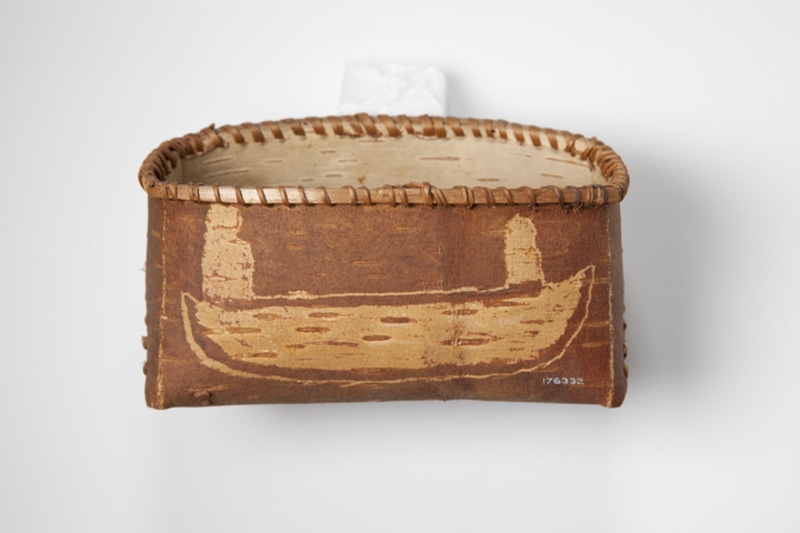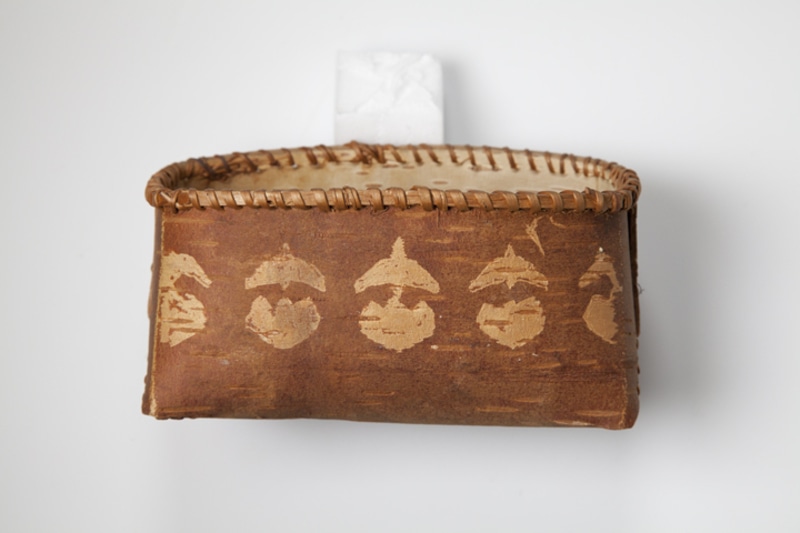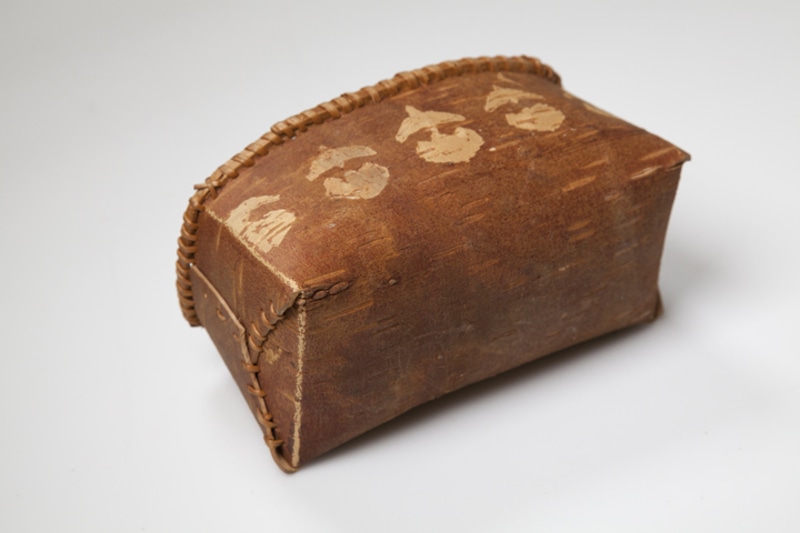basket Item Number: 1927.1734 . 176332 from the The Field Museum




Citations From Vanstone (1982) Article
« A fourth basket is similar in construction to those just described, but is much smaller and narrower and has no lid (fig. 9n). »
Vanstone, James W. "The Speck Collection of Montagnais Material Culture from the Lower St. Lawrence Drainage, Quebec." Fieldiana. Anthropology. New Series, No. 5 (October 29, 1982), p.9, fig 9n (p.37).
« A different technique has been used to decorate the small, uncovered basket. Negative designs are produced by scraping them into the dark coating of the inner bark so that they are shown a lighter color than the surrounding bark (Speck, 1937, p. 72). On one side of this basket are what appear to be a series of crude floral designs and on the other a crude representation of a canoe with two occupants (fig. 9n). » Ibis.
« Speck (1935, pp. 190-191) has noted that for the Montagnais, the symbolic pictorial representation of a plant or animal was equivalent to the actual plant or animal and those portrayed were believed to come under the control of the individual human spirit. Dreams played a major part in suggesting the relationship between specific animals or plants and an individual. The spirit was strengthened by having its dream promptings obeyed and success in subsistence activities was thereby assured. »
Vanstone, James W. "The Speck Collection of Montagnais Material Culture from the Lower St. Lawrence Drainage, Quebec." Fieldiana. Anthropology. New Series, No. 5 (October 29, 1982), p.10.
Translation Of Citations From Vanstone (1982) Article
Un quatrième panier ressemble à la construction de ceux qui viennent d’être décrits, mais s’avère beaucoup plus petit et étroit, il ne comporte pas de couvert (fig. 9n).»
Vanstone, James W. "The Speck Collection of Montagnais Material Culture from the Lower St. Lawrence Drainage, Quebec." Fieldiana. Anthropology. New Series, No. 5 (October 29, 1982), p.9, fig 9n (p.37).
« Une technique différente à été utilisée pour décorer le petit panier sans couvercle. Des motifs négatifs sont produits en grattant l’enrobage foncé de l’intérieur de l’écorce, afin qu’ils soient d’une couleur plus claire que le reste du panier (Speck, 1937, p. 72). Sur un côté de ce panier se trouve ce qui semble être une série de motifs floraux grossiers, et sur l’autre côté une représentation grossière d’un canot avec deux occupants (fig. 9n). » Ibis.
« Speck (1935, pp. 190-191) a noté que pour les Montagnais, la représentation symbolique picturale d’une plante ou d’un animal était équivalente à la plante ou à l’animal en question et que l’on croyait que les sujets de ces représentations devenaient sous le contrôle de l’esprit humain de l’individu. Les rêves jouaient un rôle majeur en suggérant des relations entre un individu et certains animaux ou certaines plantes spécifiques. L’esprit était renforcé lorsqu’on obéissait aux conseils exprimés par ses rêves et que le succès des activités de subsistance était alors assuré. »
Vanstone, James W. "The Speck Collection of Montagnais Material Culture from the Lower St. Lawrence Drainage, Quebec." Fieldiana. Anthropology. New Series, No. 5 (October 29, 1982), p.10, fig 9l (p.37).
Item History
- Made in Pekuakami, Lac Saint-Jean, Lake St. John, Labrador, Canada
What
- Name
- basket
- Identification Number
- 1927.1734 . 176332
- Type of Item
- basket
- Material
- birch bark
Who
- Culture
- Ilnu, Montagnais and Innu
Where
- Holding Institution
- The Field Museum
- Made in
- Pekuakami, Lac Saint-Jean, Lake St. John, Labrador, Canada
Other
- Nom De L'objet
- Panier
- Matériaux
- écorce de bouleau
- Ethnic Group
- Montagnais
- Collection
- Lake St. John Objects
- Provenience
- North America, Canada, Quebec, Labrador, Lake St. John